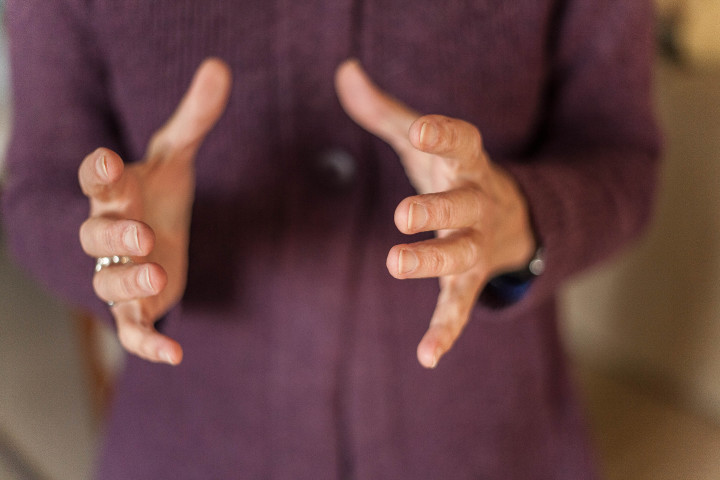Touch has the power to heal, or at the very least to soothe us when we’re not feeling well.
In Asheville, several practitioners apply this power, using a method of therapeutic touch created in the 1970s by Dora Kunz and Delores Krieger.
“We are energy fields,” says Padma Dyvine, an Asheville-based practitioner for more than 20 years and a hospice nurse. She’s one of two practitioners in the state who are certified by the Therapeutic Touch International Association. “Therefore, therapeutic touch can be done on dogs, cats, horses, humans and even on plants, because even a plant is an energy system.”
Kunz, a former president of the Theosophical Society in America, and Krieger, a nursing-science educator, created the therapeutic touch method for health-care practitioners as “a holistic, evidence-based therapy that incorporates the intentional and compassionate use of universal energy to promote balance and well-being.” Furthermore, it is “a consciously directed process of energy exchange during which the practitioner uses the hands as a focus to facilitate the process.”
Krieger, a nursing-science educator, noted therapeutic touch’s roots in ancient healing practices, such as the laying on of hands, and argued that such energy work was missing from the health care setting, Dyvine explains. The educator outlined ways that an individual’s intention, combined with a set movements similar to those of qigong or reiki, could have a positive effect on the individuals receiving care and could create a healing environment, Dyvine says.
“When we realize we are not separate from the environment, we have an opportunity to relate to our environment in an expanded way, where we use the energy in our hands, minds and intentions to support healing. Everyone can learn therapeutic touch,” says Dyvine.
To begin, practitioners “finds their center,” which is as simple as tuning into the breath, quieting the mind and focusing on the highest good for patient. The therapeutic touch practitioner then assesses the energy field of the person receiving care, which can be done while the person is sitting in a chair or lying in a bed. The practitioner follows with a series of brushing hand movements around the recipient’s body.
At no point does the practitioner physically touch the patient, Dyvine notes, although the hands may come within centimeters of the patient’s clothing. There is no physical contact in therapeutic touch, because the practice works on the energy level, and the hand movements are designed to assist patients balance their energy fields, she says.

The hidden jewel of the healing method is the degree of empowerment and accessibility it can bring to a family, relationship or environment, she continues. Practitioners “can also teach what they know and share the method with the recipient and/or family members,” Dyvine says. “In the end, it can also become an empowering process for [patients and] their families, as they can easily learn the techniques, starting with centering themselves, assessing the field, then balancing or channeling energy where needed. This is a total win-win situation. Everyone benefits.”
During the interview with Xpress, Dyvine demonstrated how to work with someone who is not in the immediate area, such as family members or people in other parts of the world who would benefit from healing — like my father, who is just recovering from a heart attack and living in another state. Applying therapeutic touch across long distances requires the use of a strong and conscious intention, as well as visualization of the person receiving healing, she explains.
For me, it was a sweet process of compassionately intending the best outcome and general healing for someone else.
It is important to note that in this system of energy healing, a distinction is made between healing and curing. “With a cure, you are trying to bring a person back to a state they once resided in, and with healing we are aware that the journey will take us to another state, potentially somewhere we haven’t been before.” says Dyvine.
In each session, those receiving care are learning how to be present and listen to what is happening in their bodies and minds. The results of a treatment may be subtle and at other times quite dramatic, depending upon the care that’s needed. In Dyvine’s experience, no one has reported adverse experiences, and often people note increased relaxation and peacefulness, in addition to healing of some conditions.
“For the practitioner — lay or professional — therapeutic touch is basically learning how to be present to one’s self — learning how to listen to what is happening in [your] mind and body, using the hands as tools,” says Dyvine.
“When you know how to listen to yourself, you can also deeply listen to others and create conditions for healing.” says Dyvine.
“That being said, it is a process. So the more a practitioner or person practices, the more skilled they become in understanding themselves and the more they have to offer others,” she emphasizes. Therapeutic touch is a way to realize that ” you have the power to feel your own energy, create intention and facilitate your own healing.”
“We each can create conditions for healing, conditions for growth, and conditions for opportunity for ourselves and others. What a beautiful gift each of us is when we move beyond our separateness, connect energetically and actualize our potential for healing in this fashion.”




Before you comment
The comments section is here to provide a platform for civil dialogue on the issues we face together as a local community. Xpress is committed to offering this platform for all voices, but when the tone of the discussion gets nasty or strays off topic, we believe many people choose not to participate. Xpress editors are determined to moderate comments to ensure a constructive interchange is maintained. All comments judged not to be in keeping with the spirit of civil discourse will be removed and repeat violators will be banned. See here for our terms of service. Thank you for being part of this effort to promote respectful discussion.